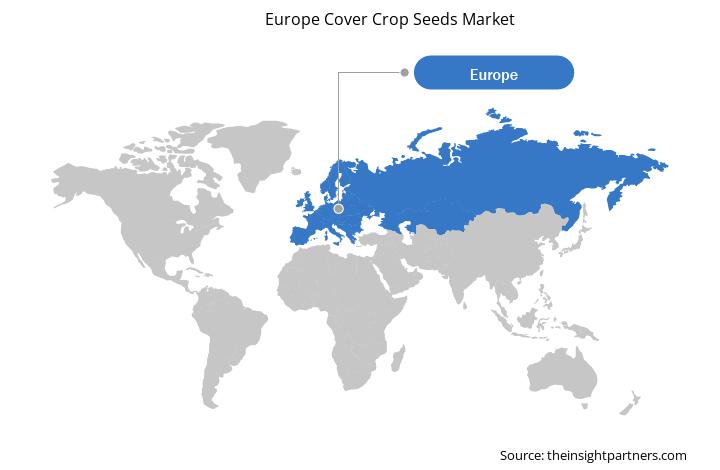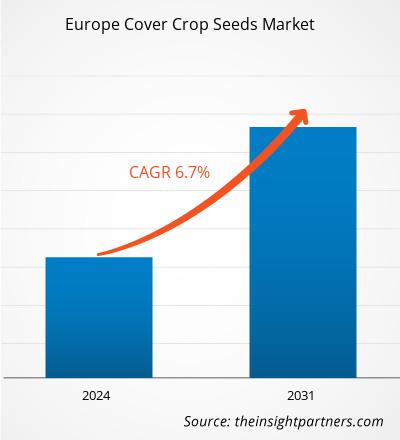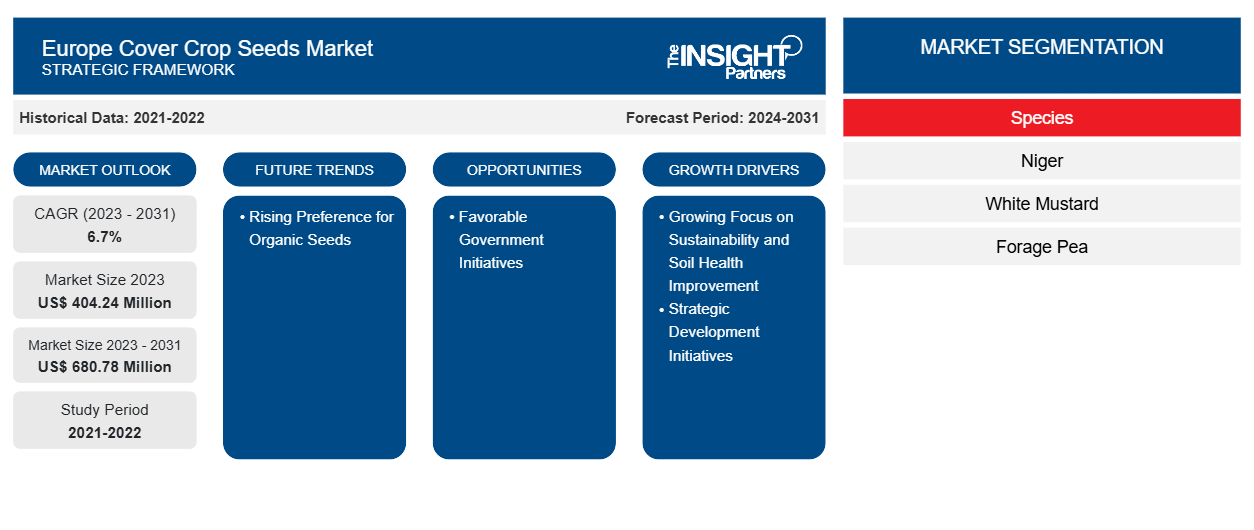ヨーロッパのカバークロップ種子市場規模は、2023年の4億424万米ドルから2031年には6億8078万米ドルに成長すると予測されており、2023年から2031年にかけて市場は6.7%のCAGRを記録すると予想されています。有機種子への嗜好の高まりは、市場の主要なトレンドになる可能性があります。
ヨーロッパのカバークロップ種子市場分析
欧州のカバークロップ種子市場は、持続可能な農業の実践を目指す政府の政策や補助金による取り組みの増加により、力強い成長を遂げています。欧州の農業業界は、環境保護と気候変動の緩和を支援するよう政策立案者や社会からますます大きなプレッシャーと期待を受けています。カバークロップは、これらの目標に貢献できる可能性のある、あまり活用されていない農業慣行です。2023~2027年に改革された共通農業政策は、欧州連合でより持続可能で公正な農業システムを推進することを目指しています。提案されている対策の中で、冬季に土壌を覆うためのカバークロップの導入を奨励することは、土壌構造の改善や栄養素の浸出や浸食の減少など、多くの利点をもたらします。これにより、欧州諸国全体でカバークロップ種子の需要が大幅に増加するでしょう。
ヨーロッパのカバークロップ種子市場の概要
ヨーロッパでは、持続可能な農業慣行と土壌の健全性管理に関する認識が高まっています。農家は土壌の肥沃度を高め、浸食を抑制し、水分保持を強化するためにカバークロップを採用しています。カバークロップの使用は化学肥料や農薬の必要性を減らすのに役立ち、環境に優しい農業アプローチを促進します。ヨーロッパでも同様の傾向が見られ、欧州連合の共通農業政策 (CAP) は、環境的に持続可能な農業を促進する取り組みの一環としてカバークロップの採用を奨励しています。フランス、ドイツ、英国などの国々は、土壌構造を改善し、土壌に炭素を隔離することで気候変動を緩和する利点があるため、カバークロップの採用をリードしています。したがって、これらの地域のカバークロップ種子市場は、持続可能な農業ソリューションに対するニーズの高まり、政府の支援、および土壌の健全性を高め、投入コストを削減するカバークロップの長期的な利点に関する農家の認識の高まりによって推進されています。
要件に合わせてレポートをカスタマイズする
このレポートの一部、国レベルの分析、Excelデータパックなど、あらゆるレポートを無料でカスタマイズできます。また、スタートアップや大学向けのお得なオファーや割引もご利用いただけます。
- このレポートの主要な市場動向を入手してください。この無料サンプルには、市場動向から見積もりや予測に至るまでのデータ分析が含まれます。
ヨーロッパのカバークロップ種子市場の推進要因と機会
持続可能性と土壌の健全性改善への注目の高まり
近年、ヨーロッパ全土の農業慣行はパラダイムシフトを経験しており、土壌の健全性を長期にわたって維持、改善することで作物の収穫量を増やす再生農法がますます重視されています。このシフトは、土壌の劣化、生物多様性の喪失、環境汚染を徐々に引き起こしてきた集約農業の有害な影響と闘う必要性によって主に推進されています。マメ科植物、イネ科植物、アブラナ科植物として、カバークロップは農業生態系でさまざまな目的を果たします。カバークロップは土壌浸食を減らし、水分保持を改善し、特に土壌中の窒素を固定することで栄養素の利用性を高めます。したがって、これらの作物は主に収穫や利益のためではなく土壌の質を改善するために栽培されており、再生農業におけるその役割は広く認識されつつあります。カバークロップの種子は持続可能な農業に不可欠な要素と見なされるようになり、ヨーロッパ諸国で採用が進んでいます。大規模な単一栽培は土壌枯渇の主な原因の 1 つであり、カバークロップは失われた栄養素を補充し、土壌の肥沃度を回復するための解決策と見なされています。さらに、被覆作物は、作物の健全な成長を助ける有益な昆虫や微生物の生息地を提供することで、生物多様性を促進します。これらの地域の農家は、輪作システムの一部として被覆作物を採用することの長期的な利点をますます認識しており、これは従来の農業慣行による有害な影響を軽減するのに役立ちます。
政府の好ましい取り組み
ヨーロッパのいくつかの政府イニシアチブは、土壌の健全性の促進、水質の改善、生物多様性の強化を目的としており、これらはすべて農業部門の長期的な存続に貢献しています。さらに、さまざまなプログラムは、気候変動に直面する中で極めて重要な、農業の環境への影響の削減にますます重点が置かれることと連携しています。この地域の政府は、持続可能性と農業生産性の目標を達成するための重要なツールとして、カバークロップ種子の可能性をますます認識しており、その結果、農家がこれらの慣行を採用できるように支援するためのさまざまな政策措置と財政的インセンティブが考案されています。
欧州では、EU が共通農業政策 (CAP) を通じてカバー クロップの使用を促進する上で重要な推進力となっています。EU 予算のかなりの部分を占める CAP は、カバー クロップ種子の使用を含む持続可能な農業慣行を採用する農家にさまざまな補助金や支払いを提供しています。CAP には、特定の直接支払いの資格を得るために農家が作物を多様化し、カバー クロップなどの生態学的重点分野 (EFA) を維持することを義務付けるグリーン化措置が含まれています。さらに、EU のグリーン ディールとファーム トゥ フォーク戦略は、持続可能な農業慣行を強調し、土壌の肥沃度を高め、炭素隔離を増やし、化学肥料への依存を減らすためにカバー クロップを奨励しています。これらの政策は、農業部門をより回復力があり環境に優しいものに変革することを目的としており、大陸全体でカバー クロップ種子の需要が高まると予想されています。ヨーロッパでこれらの政府の取り組みが収束することで、カバー クロップ種子市場に大きな成長の機会が生まれます。農家は持続可能な農法を採用するために財政的支援と技術的支援の両方を受けるため、今後数年間で市場は大幅な成長が見込まれます。
ヨーロッパのカバークロップ種子市場レポートのセグメンテーション分析
ヨーロッパのカバー作物種子市場分析の導出に貢献した主要なセグメントは種です。
- 種に基づいて、ヨーロッパのカバークロップ種子市場は、ニジェール、ホワイトマスタード、飼料用エンドウ、一般的なベッチ、ライ麦、剛毛オート麦、ソバ、カバークロップ混合物、飼料用大根、カブナタネ、その他に分類されます。カバークロップ混合物セグメントは、2023年に最大の市場シェアを占めました。
ヨーロッパのカバークロップ種子市場シェア分析(国別)
ヨーロッパのカバークロップ種子市場レポートの範囲は、さらにドイツ、イギリス、フランス、イタリア、スペイン、ロシア、その他のヨーロッパに分かれています。ドイツは、予測期間中に最高の CAGR を記録すると予想されています。過去数十年間、ドイツにおけるカバークロップ種の多様性は低いものでした。シロガラシとオイルシードラディッシュは、バイオマス生産量が高く、特定の品種がテンサイやジャガイモなどの輪作における植物病原性線虫の個体数を減らす能力があるために栽培されています。また、浸出による硝酸塩損失のリスクを減らし、合理的な雑草抑制を提供します。ファセリアは、ドイツではどの主要作物とも関連がないため、カバークロップとして一般的に栽培されています。さらに、一般的な害虫や作物の病気のホストになる可能性も低いです。
2023年にはフランスが最大の市場シェアを占めました。フランスでは、環境、経済、規制の要因が重なり、カバークロップ種子の需要が増加しています。欧州グリーンディールと「農場から食卓へ」戦略によって推進される持続可能な農業慣行の急増により、カバークロップは土壌の健康を改善し、生物多様性を高め、合成肥料などの化学物質の投入を減らすための重要なツールと見なされています。フランスでは、冬は土地を休耕し、冬小麦や冬大麦などの夏に収穫した作物の後にカバークロップを植えて、硝酸塩の浸出を制限し、土壌浸食を最小限に抑えます。マスタードは、コストが低く、栽培が容易なため、カバークロップとしてよく使用されます。
ヨーロッパのカバークロップ種子市場地域別分析
予測期間を通じてヨーロッパのカバークロップ種子市場に影響を与える地域的な傾向と要因は、Insight Partners のアナリストによって徹底的に説明されています。このセクションでは、ヨーロッパのカバークロップ種子市場のセグメントと、北米、ヨーロッパ、アジア太平洋、中東、アフリカ、南米、中米の地理についても説明します。

- ヨーロッパのカバークロップ種子市場の地域別データを入手
ヨーロッパのカバークロップ種子市場レポートの範囲
| レポート属性 | 詳細 |
|---|---|
| 2023年の市場規模 | 4億424万米ドル |
| 2031年までの市場規模 | 6億8,078万米ドル |
| 世界のCAGR(2023年~2031年) | 6.7% |
| 履歴データ | 2021-2022 |
| 予測期間 | 2024-2031 |
| 対象セグメント | 種によって
|
| 対象地域と国 | ヨーロッパ
|
| 市場リーダーと主要企業プロフィール |
|
ヨーロッパのカバークロップ種子市場のプレーヤー密度:ビジネスダイナミクスへの影響を理解する
ヨーロッパのカバークロップ種子市場は、消費者の嗜好の変化、技術の進歩、製品の利点に対する認識の高まりなどの要因により、エンドユーザーの需要が高まり、急速に成長しています。需要が高まるにつれて、企業は提供を拡大し、消費者のニーズを満たすために革新し、新たなトレンドを活用し、市場の成長をさらに促進しています。
市場プレーヤー密度とは、特定の市場または業界内で活動している企業または会社の分布を指します。これは、特定の市場スペースに、その規模または総市場価値と比較して、どれだけの競合相手 (市場プレーヤー) が存在するかを示します。
ヨーロッパのカバークロップ種子市場で事業を展開している主要企業は次のとおりです。
- ピュアシード
- PH Petersen Saatzucht Lundsgaard GmbH
- KWS SAAT SE & Co. KGaA
- アグロリトパ
- リマグレインUK株式会社
- Feldsaten Freudenberger GmbH & Co KG
免責事項:上記の企業は、特定の順序でランク付けされていません。

- ヨーロッパのカバークロップ種子市場のトップキープレーヤーの概要を入手
ヨーロッパのカバークロップ種子市場のニュースと最近の動向
ヨーロッパのカバークロップ種子市場は、主要な企業出版物、協会データ、データベースを含む一次および二次調査後の定性的および定量的データを収集することによって評価されます。ヨーロッパのカバークロップ種子市場の動向のいくつかを以下に示します。
- ジョセフズ ベーカリーは、アメリカ心臓協会のハートチェック食品認証プログラムの認証を受けた、まったく新しいハート フレンドリー ピタパンを全国で発売しました。(出典: ジョセフズ ベーカリー、企業ウェブサイト、2024 年 10 月)
ヨーロッパのカバークロップ種子市場レポートのカバー範囲と成果物
「ヨーロッパのカバークロップ種子市場の規模と予測(2021〜2031年)」レポートでは、以下の分野をカバーする市場の詳細な分析を提供しています。
- ヨーロッパのカバー作物種子の市場規模と種の予測は、この範囲でカバーされています。
- ヨーロッパのカバークロップ種子市場の動向、および推進要因、制約、主要な機会などの市場動向
- ポーターの5つの力とSWOT分析の詳細
- 主要な市場動向、国の枠組み、主要プレーヤー、規制、最近の市場動向を網羅した、ヨーロッパのカバー作物種子市場分析。
- 市場集中、ヒートマップ分析、主要プレーヤー、ヨーロッパのカバー作物種子市場の最近の動向を網羅した業界の状況と競争分析
- 詳細な企業プロフィール
- 過去2年間の分析、基準年、CAGRによる予測(7年間)
- PEST分析とSWOT分析
- 市場規模価値/数量 - 世界、地域、国
- 業界と競争環境
- Excel データセット
最新レポート
お客様の声
購入理由
- 情報に基づいた意思決定
- 市場動向の理解
- 競合分析
- 顧客インサイト
- 市場予測
- リスク軽減
- 戦略計画
- 投資の正当性
- 新興市場の特定
- マーケティング戦略の強化
- 業務効率の向上
- 規制動向への対応





















 無料サンプルを入手 - ヨーロッパのカバークロップ種子市場
無料サンプルを入手 - ヨーロッパのカバークロップ種子市場